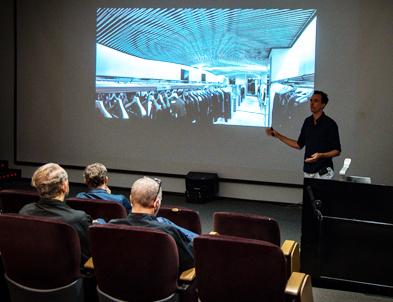- About
- Admissions
- Study at AUS
- Prospective Students
- Bachelor's Degrees
- Master's Degrees
- Doctoral Degrees
- Admission Publications
- International Students
- Contact Admissions
- Grants and Scholarships
- Sponsorship Liaison Services
- Testing Center
- New Student Guide
- File Completion
- New Student Orientation
- Payment Guide
- Executive Education
- Students with Disabilities
- Academics
- Life at AUS
- Research
- Contact Us
- Apply Now
- .

“Building simplexity: A lecture by Kristof Crolla”
On November 6, Kristof Crolla, founder of Laboratory for Explorative Architecture and Design Ltd (LEAD) and Assistant Professor in Computational Design at Chinese University Hong Kong (CUHK), addressed students from the AUS College of Architecture, Art and Design (CAAD) as part of the college’s annual lecture series by world-renowned designers and academics.
Speaking on the topic of “Building Simplexity,” Crolla emphasized the potential outcomes for a harmonious collaboration between the advancements in technology and computation, and traditional architecture and design.
Crolla’s interest in this collaboration is seen in his award-winning designs, including the Golden Moon, the Dragon Skin Pavilion, the ZCB Bamboo Pavilion, and others. These structures were all created using parametric design and computational technology—a design process that uses computer-generated algorithms or pre-programmed rules to automate the mathematics of design.
Describing his design process from inception to development to his projects’ physical realization, Crolla went on to share about the difficulties that arose during the construction of some of the more unique and complex structures he has designed.
For example, in the construction of the Bamboo Pavilion—a sinuous piece of architecture that employs the use of linear rigid elements of bamboo—Crolla was faced with an apparent discrepancy between the parametric design and the nature of the materials used.
Faced with the physical realities of the bamboo and their assembly, Crolla turned his focus to the details, connections and on-site solutions of the contractors to address the unique challenges of the build.
For designers, Crolla’s experience provides two lessons: First, despite advancement in computational design, projects do not have to conform to a module-based or standardized process in the production of modules. And second, if greater consideration is given to the assembly and detailing of a structure during the design process, architects can expect more compelling results, particularly in terms of the scale and scope of materials.
Furthermore, Crolla stressed the fact that since production processes have drastically changed over the last decade, standardization and averaging of construction processes that have now become the norm need to be questioned and criticized. He pointed out that failing to do so ultimately de-humanizes construction and creates impractical consequences for the human labor force involved.
Crolla concluded his lecture by reinforcing the truth that while designers need to stay true to design processes, the realities of construction must to be addressed to ensure the ultimate success of a project.
For more information about the impressive lineup of speakers at CAAD this year, visit our events page.

